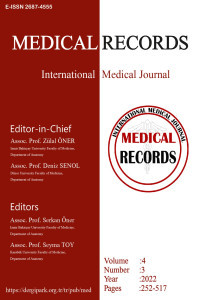Streptozotosin Diyabeti Oluşturulan Ratlarda Protein Oksidasyonunun Değerlendirilmesi
The Evaluation of Protein Oxidation in The Rats Which Induced Diabetes by Streptozotocin
Diabetes mellitus, Protein Oxidation, Methylglyoxal,
___
- Sherwin RS. Diabetes mellitus. In: Goldman L, Bennet J (eds), Cecil Textbook of Medicine (21sted). WB Saunders Company, Philedelphia. 2000,pp.1263-85.
- Kosmachevskaya OV, Novikova NN, Topunov AF. Carbonyl Stress in Red Blood Cells and Hemoglobin. Antioxidants. 2021;10(2):253. doi:10.3390/antiox10020253.
- Feillet–Coudray C, Rock E, Coudray C, et al. Lipid peroxidation and antioxidant status in experimental diabetes. Clin Chim Acta. 1999;284:31-43.
- Friedman EA. Advanced glycosylated end products and hyperglycemia in the pathogenesis of diabetic complications Diabetes Care. 1999;22:65–71.
- American Diabetes Association. Diagnosis and classification of diabetes mellitus. Diabetes Care 2014;37:81-90 https://doi.org/10.2337/dc14-S081
- Carvalho EN, Carvalho NAS, Ferreiro LM. Experimental model of induction of diabetes mellitus rats. Acta Cir Bros. 2003;18: 60-64.
- Islas S, Monsalve CR, Pena JE, et al. STZ and alloxan experimental diabetes: comparison of the two models in rats. Acta Histochem Cytochem. 2000;33:201-8
- Szkudelski T. The mechanism of alloxan and streptozotocin action in β cells of the rat pancreas. Physiol Res 2001;50:536-46.
- Sies H. oxidative Stress: oxidants And Antioxidants. Exp Physiol 1997;82: 291-95.
- Schalkwijk C. G. and. Stehouwer C.D.A. Methylglyoxal, A highly reactive dicarbonyl compound, in diabetes, its vascular complications and other age-related diseases. Physiol Rev. 2020;100(1):407-461. doi:10.1152/physrev.00001.2019.
- Kalapos MP. Methylglyoxal In Living Organisms. Chemistry, Biochemistry, Toxicology And Biological Implications. Toxicol Lett. 1999;110: 145-175.
- Sousa Silva M, Gomes R. A, Ferreira A. E. N et al. The glyoxalase pathway: the first hundred years… and beyond. Biochem J. 2013;453(1):1–15. doi:10.1042/bj20121743
- Hardeland R, Reiter RJ, Poeggeler B. et al. The significance of the metabolism of the neurohormone melatonin: Antioxidative protection and formation of bioactive substances. Neurosci Biobehav Rev. 1993;17:347-57.
- Maritim AC, Moore BH, Sanders RA. et al. Effect of melatonin on oxidative stress in streptozotocin-induced diabetic rats. Int J Toxicol. 1999;18:161-6.
- Cooper RA. Methylglyoxal Synthase. Methods Enzymol. 1975;41:502-508
- Mannervick B,Ridderstrom M:Catalytic and molecular properties glyoxalase I. Biochem Soc Trans. 1993;21:515 –17
- Racker E. The mechanisms of action of glyoxalase. J Biol Chem. 1951;190:685-96.
- Chunguang C, Christian M.C, Julia S. et al. Human beta cell mass and function in diabetes: Recent advances in knowledge and technologies to understand disease pathogenesis. Mol Metab. 2017; 6(9): 943–957. doi: 10.1016/j.molmet.2017.06.019
- Groener J, Oikonomou, D. Cheko, R. et al. Methylglyoxal and Advanced Glycation End Products in Patients with Diabetes – What We Know so Far and the Missing Links. Exp Clin Endocrinol Diabetes. 2019;127(8):497-504. doi:10.1055/s-0043-106443
- Sena CM, Matafome P, Crisostomo J et al. Methylglyoxal promotes oxidative stress and endothelial dysfunction. Pharmacol Res. 2012;65:497-506
- Yamada H, Miyata S, Igaki N et al. Increase in 3 deoxyglucosone levels in diabetic rat plasma. Specific in vivo determination of intermediate in advanced Maillard reaction. J Biol Chem. 1994;269: 20275-20280
- Nigro C, Leone, A, Raciti, G. L. et al. Methylglyoxal-Glyoxalase 1 Balance: The Root of Vascular Damage. Int J Mol Sci. 2017;18(1):188–. doi:10.3390/ijms18010188
- Nemet I, Turk Z, Dunjakd L et al. Humoral methylglyoxal level reflects gylicemic fluctuation. Clin Biochem. 2005;38:379-83.
- Phillips SA, Mirrlees D, Thornalley PJ. Modification of the glyoxalase system in streptozotocin-induced diabetic rats. Effect of the aldose reductase inhibitor statil. Biochem Pharmacol. 1993;46:805
- Ohmori S, Mori M, Kawase M. et al. Determination of methylglyoxal as 2-methylquinoxaline by high-performance liquid chromatography and its application to biological samples. J Chromatogr. 1987;414:149-55.
- Brouwers, O, Niessen, P. M, Ferreira, I. et al. Overexpression of Glyoxalase-I Reduces Hyperglycemia-induced Levels of Advanced Glycation End Products and Oxidative Stress in Diabetic Rats. J Biol Chem. 2011;286(2):1374–1380. doi:10.1074/jbc.M110.144097
- Mey, J. T., & Haus, J. M. Dicarbonyl Stress and Glyoxalase-1 in Skeletal Muscle: Implications for Insulin Resistance and Type 2 Diabetes. Front Cardiovasc Med. 2018;5:117 doi:10.3389/fcvm.2018.00117
- Raju J, Gupta D, Rao AR. et al. Effect of antidiabetic compounds on glyoxalase I activity in experimental diabetic rat liver. Indian J Exp Biol. 1999;37(2):193-5
- Cianfruglia, L, Morresi, C, Bacchetti T. et al. Protection of Polyphenols against Glyco-Oxidative Stress: Involvement of Glyoxalase Pathway. Antioxidants. 2020;9(10):1006. doi:10.3390/antiox9101006
- Stadtman ER, Berlett BS. Reactive oxygen-mediated Protein oxidation In Aging And Disease. Chem Res Toxicol. 1997;10:485-494.
- Lyons TJ. Glycation, Carbonyl Stress, Eagles, And The Vascular Complications of Diabetes. Semin Vasc Med. 2002;2:175-189.
- Hollenbach, M. The Role of Glyoxalase-I (Glo-I), Advanced Glycation Endproducts (AGEs), and Their Receptor (RAGE) in Chronic Liver Disease and Hepatocellular Carcinoma (HCC). Int J Mol Sci. 2017;18(11):2466. doi:10.3390/ijms18112466
- Singh M, Jadhav HR. Melatonin: Functions and Ligands. Drug Discov Today. 2014;19:1410–8 Montilla PL, Vargas JF, Tunez IF, et al. Oxidative stress in diabetic rats induced by streptozotocin: protective effects of melatonin. J Pineal Res. 1998;25:94-100.
- Montilla PL, Vargas JF, Tunez IF, et al. Oxidative stress in diabetic rats induced by streptozotocin: protective effects of melatonin. J Pineal Res. 1998;25:94-100.
- Yavuz O, Cam M, Bukan N. et al. Protective effect of melatonin on beta-cell damage in streptozotocin-induced diabetes in rats. Acta Histochem.2003;105:261-266.
- Yayın Aralığı: Yılda 3 Sayı
- Başlangıç: 2019
- Yayıncı: Zülal ÖNER
Üçüncü Basamak Bir Yoğun Bakım Ünitesinde Bir Yıl Içinde Ölen Hastaların Klinik Özellikleri
Ökkeş Hakan MİNİKSAR, Erol TOY
Kan Gruplarının SARS-CoV-2 Enfeksiyonu ve Prognozu Üzerine Etkisi
Humeyra ASLANER, Mebrure Beyza GÖKÇEK, Ali Ramazan BENLİ, Recep BAYDEMİR, Zeynep GÜVEN, Gülşah AKYOL, Leylagül KAYNAR
Pulmoner Embolide Yardımcı Tanı Yöntemlerinin Karşılaştırılması
Muhammed EKMEKYAPAR, Levent ŞAHİN, Şükrü GÜRBÜZ
Mahmut ŞAHİN, Cemile Ayşe GÖRMELİ, Nurullah DAĞ, Fuat KURT
Rutin bilgisayarlı tomografi incelemelerinde renal vasküler varyasyonların değerlendirilmesi
COVID-19 Pandemisi Sürecinde Sağlık Profesyonellerinin Mesleki Yorgunluklarının Değerlendirilmesi
Özlem ÇAĞAN, Zeynep IRMAK KAYA
Ciddi Epistaksis olan Hastalarda Rutin Koagülasyon Teslerinin Değerlendirmesi
Bora ÇEKMEN, Öner BOZAN, Şeref Emre ATİŞ, Sevilay Sema ÜNVER, Kamil KOKULU, Asım KALKAN
İnfratemporal Locaya Deplase Olmuş Maksiller Üçüncü Molar Dişin İntraoral Yaklaşım İle Çıkartılması
Metin Berk KASAPOĞLU, Gözde GÖKÇE, Ahmet Taylan ÇEBİ, Burak ÇANKAYA
Türk Hemşirelik Öğrencilerinin Gözünden Yaşam Sonu Bakım ve Ölüm: Bir Kalitatif Araştırma
Esin CERİT, Dilek EFE ARSLAN, Nazan KILIÇ AKÇA, Nuray ŞİMŞEK
